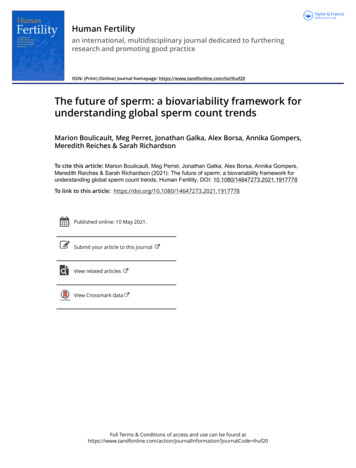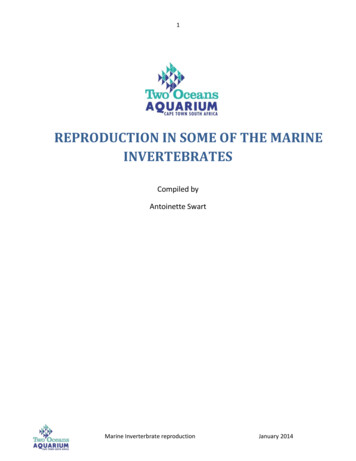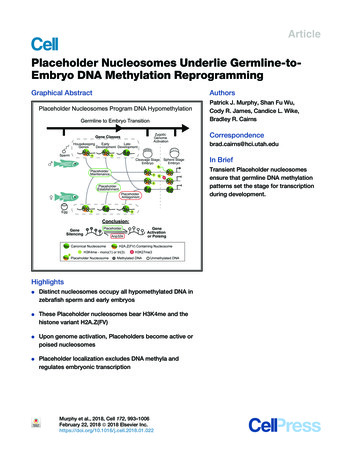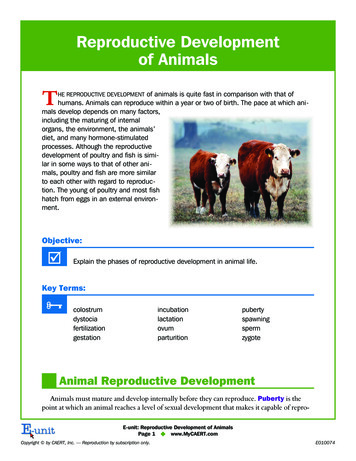
Transcription
Human Fertilityan international, multidisciplinary journal dedicated to furtheringresearch and promoting good practiceISSN: (Print) (Online) Journal homepage: https://www.tandfonline.com/loi/ihuf20The future of sperm: a biovariability framework forunderstanding global sperm count trendsMarion Boulicault, Meg Perret, Jonathan Galka, Alex Borsa, Annika Gompers,Meredith Reiches & Sarah RichardsonTo cite this article: Marion Boulicault, Meg Perret, Jonathan Galka, Alex Borsa, Annika Gompers,Meredith Reiches & Sarah Richardson (2021): The future of sperm: a biovariability framework forunderstanding global sperm count trends, Human Fertility, DOI: 10.1080/14647273.2021.1917778To link to this article: shed online: 10 May 2021.Submit your article to this journalView related articlesView Crossmark dataFull Terms & Conditions of access and use can be found ation?journalCode ihuf20
HUMAN 7778ORIGINAL ARTICLEThe future of sperm: a biovariability framework for understanding globalsperm count trendsMarion Boulicaulta,b, Meg Perretc, Jonathan Galkac, Alex Borsad, Annika Gomperse, Meredith Reichesf andSarah Richardsonc,gaDepartment of Philosophy and Linguistics, Massachusetts Institute of Technology, Cambridge, MA, USA; bDepartment of Philosophy,University of Adelaide, Adelaide, Australia; cDepartment of the History of Science, Harvard University, Cambridge, MA, USA;dDepartment of Sociomedical Sciences, Columbia University, New York, NY, USA; eDepartment of Obstetrics and Gynecology, BethIsrael Deaconess Medical Center, Boston, MA, USA; fDepartment of Anthropology, University of Massachusetts, Boston, MA, USA;gCommittee on Degrees in Studies of Women, Gender, and Sexuality, Harvard University, Cambridge, MA, USAABSTRACTARTICLE HISTORYThe past 50 years have seen heated debate in the reproductive sciences about global trends inhuman sperm count. In 2017, Levine and colleagues published the largest and most methodologically rigorous meta-regression analysis to date and reported that average total sperm concentration among men from ‘Western’ countries has decreased by 59.3% since 1973, with nosign of halting. These results reverberated in the scientific community and in public discussionsabout men and masculinity in the modern world, in part because of scientists’ public-facingclaims about the societal implications of the decline of male fertility. We find that existingresearch follows a set of implicit and explicit assumptions about how to measure and interpretsperm counts, which collectively form what we term the Sperm Count Decline hypothesis (SCD).Using the study by Levine and colleagues, we identify weaknesses and inconsistencies in theSCD, and propose an alternative framework to guide research on sperm count trends: theSperm Count Biovariability hypothesis (SCB). SCB asserts that sperm count varies within a widerange, much of which can be considered non-pathological and species-typical. Knowledge aboutthe relationship between individual and population sperm count and life-historical and ecological factors is critical to interpreting trends in average sperm counts and their relationships tohealth and fertility.Received 1 October 2020Accepted 5 March 2021Introduction‘Who’s Killing America’s Sperm?’ read a 2017 cover ofNewsweek magazine (Walsh, 2017). ‘Within a generation, men may lose the ability to reproduce entirely,’pronounced Gentleman’s Quarterly (Halpern, 2018).‘Western nations – although not developing countries– appear to be facing disaster,’ added The Guardian(McKie, 2017).The instigating event was the publication, inHuman Reproduction Update, of a meta-analysis of global sperm count change over time (Levine et al.,2017). The authors reported that total sperm countand sperm concentration (hereafter ‘sperm count’) hasdeclined by more than 50% among ‘Western’ menbetween 1973 and 2011. ‘Western’ populationsincluded North America, Europe, Australia and NewZealand. They were contrasted with ‘Other’ populations from South America, Asia, and Africa, whereCONTACT Marion BoulicaultCambridge, MA 02139, USAß 2021 The British Fertility Societymarionb@mit.eduKEYWORDSSperm count decline; malereproductive health; malefertility; semen analysis;andrology; humanreproductionsperm count declines were not found to be statistically significant (Levine et al., 2017, pp. 650, 654).In this paper, we locate the interpretation byLevine and colleagues of recent human sperm counttrends within a conceptual framework that we call theSperm Count Decline (SCD) hypothesis. We contrastthe SCD hypothesis with a proposed alternative, whichwe call the Sperm Count Biovariability (SCB) hypothesis. SCD and SCB represent two interpretive frameworks for the same data and generate differentresearch programmes for the study of sperm counttrends in human populations. We contrast four propositions of the SCD and SCB hypotheses, summarised inTables 1 and 2, and argue that SCB offers a more analytically rigorous, empirically driven, and generativeframework for designing data collection protocols andinterpreting population trends in human sperm countsthan does SCD. The SCB offers improved tools bothDepartment of Philosophy and Linguistics, Massachusetts Institute of Technology, 32 Vassar St,
2M. BOULICAULT ET AL.Table 1. Two hypotheses for interpreting trends in human sperm count.Sperm Count Decline (SCD) hypothesisSperm Count Biovariability (SCB) hypothesisSperm count is declining and will likely continue to decline in the futureat similar rates. Sperm count is an indicator of male health across thelifespan. Both men’s health and human male fertility are in peril asaverage sperm counts decrease. The most likely causes of precipitoussperm count decline among Western populations are endocrinedisruptors and other environmental pollutants introduced byindustrialisation, as well as changes in men’s lifestyles in themodern world.Sperm count varies within a wide range, much of which can beconsidered non-pathological and species-typical. Above a criticalthreshold, more is not necessarily an indicator of better health orhigher probability of fertility relative to less. Sperm count varies acrossbodies, ecologies, and time periods. Knowledge about the relationshipbetween individual and population sperm count and life-historical andecological factors is critical to interpreting trends in average spermcounts and their relationships to human health and fertility.for the re-analysis of existing epidemiological data andfor the design, analysis, and interpretation of futureresearch on sperm counts, environment, andmen’s health.sub-fertility or with exposures that may affect fertility,such as smoking.The study nonetheless had significant limitations,acknowledged by its authors: for example, men’s ageswere unknown in more than one third of the samples,and in 45% of samples, the year of collection wasunknown and had to be imputed. Other limitationswere not explicitly addressed. For example, theauthors sought to overcome previous meta-analyses’methodological weaknesses by including only studiesthat used a haemocytometer, the method outlined inthe WHO laboratory manual for the examination andprocessing of human semen (World HealthOrganization, 2010), to measure sperm count. But thismay be insufficient for commensurability. During theperiod spanned by the data, there were significantchanges to training protocols and quality controlschemes for semen analysis (Pacey, 2013). Additionally,the authors do not control for the conditions underwhich research participants produce sperm samples,which may affect arousal and in turn semen quality(Joseph et al., 2015; Pound et al., 2002).The third reason we focus on Levine et al. is thatthe paper has entered public discourse, and has beenmarshalled in service of the narrative that the fertilityand health of men in whiter, ‘Western’ nations are inimminent danger (Clancy & Davis, 2019; Halpern,2018). Such narratives about the decline of men havebeen taken up by white supremacist and misogynistgroups who claim that men in the Global North arevictims of their liberal feminist environments (Ferber,1999; Moore, 2002; Moore, 2018; Robinson, 2000). Inaddition to promoting a distorted picture of the contributors to male reproductive health in contemporarysocieties, these claims obscure environmental reproductive harms and fertility struggles experienced bymen in East Asia, the Middle East, and the GlobalSouth (Inhorn, 2013; Inhorn & Patrizio, 2015;Wahlberg, 2018).The Levine et al. (2017) meta-analysis treats‘Western’ and ‘Other’ as appropriate, implying thatthere are stable differences in bodies and environments across these categories and across time. ForHistory and social context of the sperm countdecline debateLevine et al. (2017) are not the first or most recentresearchers to suggest that contemporary social andphysical environments harm sperm production in men.Debates over whether sperm counts are declining andwhat such decline might mean have been taking placefor decades (Carlsen et al., 1992; Daniels, 2006; Nelson& Bunge, 1974; Sengupta, Dutta et al., 2017; Sengupta,Nwagha et al., 2017; Sengupta, Borges et al., 2018;Sengupta, Dutta et al., 2018, Swan & Colino, 2021).Recent research on sperm count decline is associatedwith a broader research programme postulating a risein andrological pathologies, resulting from a hypothesised Testicular Dysgenesis Syndrome, or TDS (Akre &Richiardi, 2009; Skakkebaek et al., 2001). Here we focusour analysis on Levine and colleagues’ meta-analysisfor three reasons.First, the scientific impact of Levine et al. (2017) issignificant: their paper was the top cited paper in2017 in Human Reproduction Update, a leading journalin the field (Human Reproduction Update, OxfordAcademic, n.d.; Web of Science, 2020).Second, the paper avoids some of the methodological weaknesses that provoked scepticism withinthe scientific community about other claims of spermdecline (Carlsen et al., 1992; Daniels, 2006), grantingtheir findings unprecedented authority among reproductive scientists (Science Media Centre, 2017).Specifically, they created rigorous criteria so as to onlyinclude studies that used commensurate sperm countmeasurement techniques; attempted to extract dataon a wide range of potential confounders; implemented a systematic quality control protocol; conducted several sensitivity analyses; and excludedsamples that were selected for men with infertility or
HUMAN FERTILITYexample, it assumes that it is conceptually warrantedto compare average population sperm counts among‘Western’ men in the 1970s to ‘Western’ men in 2013.Further, it implies that the sperm counts of 1970sWestern men represent an optimum compared to2013 average sperm counts. This formulation situatesmen’s bodies and environments labelled ‘Western’ asexemplary, natural, and now imperilled.Men’s Rights Activist (MRA) groups, an outgrowthof the men’s liberation movement formed in reactionto feminism and a perceived crisis of masculinity incontemporary societies (Manne, 2018; Stern, 2019),seized on the interpretation of Levine et al. (2017)that contemporary chemical and social environmentsare hostile to Western masculinity. Discussions onsome of the most prominent MRA online forums haveframed the study as proof that Western civilisation hasdoomed itself (T. Moore, 2018). Far right conspiracytheorist Alex Jones linked the drop in Western men’ssperm counts to the eroding social status and feminisation of men, and connected it to claims of decliningtestosterone levels and derisive ‘soy boy’ theoriesabout the feminising effects of oestrogen-containingsoy products (Henderson, 2018). Levine et al. (2017)appeared to affirm the idea that men’s putativelydeclining social status was indeed behind the declines:‘Social factors could definitely influence this Weare animals. The social rank, the socioeconomic position, is important,’ Levine was quoted as saying inThe New York Times (Bowles, 2018).Contrasting the sperm count decline andsperm count biovariability hypothesesIn this paper we contrast the Sperm Count Declineand Sperm Count Biovariability hypotheses. We3understand a hypothesis as not only a set of propositions open to empirical testing, but also as a set ofimplicit and explicit model-theoretic assumptionsabout the world that provides a framework for collecting and interpreting new and existing data and settingresearch agendas.The SCD hypothesis interprets data on sperm countover time as a metric of men’s potential fertility, aproxy for men’s health, and an assay of environmentalquality. According to SCD, a decline in ‘Western’ spermcounts from 1970s levels indicates a decline in malefertility, health, and a sign of a degrading environment. By contrast, the SCB hypothesis allows for thepossibility of both pathological and non-pathologicalvariation in sperm counts across populations and time.SCB begins with the premise that, above the thresholdnecessary for fertility, there is no basis to assume thathigh average population sperm counts are optimal.Nor is there any reason to believe that sperm countsin the 1970s are a species-typical baseline. SCB positsthat sperm count varies within and across bodies inways that are compatible with health such that adecline in an individual or population may not necessarily signal danger to fertility or well-being. Weemphasise that while SCB invites a wider explanationand interpretation of sperm count trends, it does notexclude the possibility of sperm count decline or thatdecline may carry implications for men’s health andfertility. The SCB hypothesis provides a framework forexploring the trends identified by Levine et al. (2017)that considers the possibility that these trends can beexplained by benign or adaptive variation in spermcounts in relation to diverse contexts and factors.Rather than treat nations or regions of global wealthas proxies for stable populations or biologically meaningful environments, SCB calls for testing linksTable 2. Contrasting interpretations of sperm count trends: Sperm Count Decline (SCD) vs. Sperm Count Biovariation(SCB) hypotheses.Sperm Count Decline (SCD)(1) Sperm and FertilityFertility scales proportionately with sperm count, and a recent drop insperm count means that fertility is already imperilled.(2) Sperm and Overall HealthAverage population sperm count is a biomarker of the overall healthstatus of men.(3) Sperm Count and Environmental PollutantsDeclining sperm counts since 1973 in ‘Western’ countries are likely theresult of environmental endocrine disrupting chemicals.(4) ‘West,’ ‘Other,’ and Nations as Units of PopulationThe average sperm count in a population sample and in a given year issufficiently meaningful for comparing populations and describingpopulation trends. Global sperm decline is linear and continuous.Sperm Count Biovariation (SCB)Male infertility is a complex biological and social phenomenon that is notpredicted by the single metric of sperm count.The connection between sperm count and health is mediated by theindividual’s recent experience and prior life history. The short timescales for sperm regeneration make sperm non-ideal for trackinghealth status.The relationship between endocrine disrupting chemicals, geography, andsperm count has not been established by prospective studies acrosspopulations that control for confounders and use repeat individualmeasures in combination with a wide variety of social andbiological measures.Sperm counts rise and fall and vary across populations and time, andwithin individuals, in a dynamic, non-linear and noncontinuous fashion.
4M. BOULICAULT ET AL.between specific developmental and proximate stimuliand sperm count outcomes, recognising human biological variation as local and situated (Lock, 2017;Niewohner & Lock, 2018).From an SCB perspective, the data points thatmake up the 2017 meta-analysis simply demonstratethat sperm count varies across bodies, ecologies, andtime periods. Examining the same data and background literature with a different set of assumptions,SCB argues that the interpretation that populationsperm counts vary within a wide optimum with littleconsequence for fertility is at least as plausible as theinterpretation that steady decline occurs.We argue in favour of the SCB as a framework forinterpreting population trends in human spermcounts. It identifies testable hypotheses that includeboth pathological and non-pathological explanationsfor and outcomes of observed variation in spermcounts. Table 2 contrasts the propositions of the SCDand SCB hypotheses. In the following sections, weanalyse each proposition pair in turn.1. Sperm count and men’s fertilityThe SCD hypothesis contends that lower averagepopulation sperm counts portend higher rates of maleinfertility, positioning sperm count decline as a markeror cause of reproductive crisis for the human species.Levine et al. (2017) for example, infer that ‘decliningmean [sperm count] implies that an increasing proportion of men have sperm counts below any giventhreshold for sub-fertility or infertility’. Levine et al.(2017) link this to claims of increasing ‘economic andsocietal burden of male infertility’ (p. 649).There is little evidence that this is true. Levine et al.(2017) contend that the high circa 1973 numbers represent normal, healthy, and natural levels, whiletoday’s numbers represent a crisis and decline from aprior optimum. But current Western average spermcounts reported by Levine et al. (2017) for men unselected for fertility are well within the ‘normal’ range,defined by the World Health Organisation (WHO) as15–259 million per mL for individuals (World HealthOrganization, 2010, p. 224). That is, the Levine et al.(2017) study reports a population average declinefrom ‘normal’ (99 million sperm per ml) to ‘normal’ (47million sperm per ml). Furthermore, in absolute numbers, the 2009–2011 Unselected Western sperm counts(47.1 million/mL), which are ostensibly cause for alarm,are in fact relatively close to absolute sperm counts in‘Other’ countries back in the 1978–1983 period (66.4million/mL for Fertile Other, 72.7 million/mL forUnselected Other) and in the 2010–2011 period (75.7million/mL for Fertile Other, 62.6 million/mL forUnselected Other).Male infertility is a complex biological and socialphenomenon that cannot be understood in terms ofthe single metric of sperm count (Guzick et al., 2001).Though azoospermia (sperm count of zero) guaranteesinfertility, researchers have found that some men withlow sperm counts can conceive, while others withhigher counts cannot (Patel et al., 2018; Wang &Swerdloff, 2014). Guzick et al. (2001) demonstrate thateven sperm concentrations in the so-called sub-fertilerange of less than 13.5 million/mL ‘do not exclude thepossibility of normal fertility’ (p. 1392). Of note, the2010 WHO reference values for semen parameters donot predict infertility, as the values were determinedby studying fertile men; therefore, while the top 95%of sperm concentrations in the sample were taken tobe the reference range, all of the men with spermconcentrations below the 5th centile were also fertile(Chiles & Schiegel, 2015; Cooper et al., 2010). Otherstudies from across the world have similarly confirmedthe fertility of men below the WHO reference values(Haugen et al., 2006; Tang et al., 2015; Zedanet al., 2018).Clinicians do not report proportionate increases ininfertile men presenting for clinical consultation overLevine et al.’s study period (Inhorn & Patrizio, 2015).As urologist Peter Schlegel remarked in The New YorkTimes in reference to the Levine et al. (2017) metaanalysis, ‘If you had a decrease in sperm count in the50 to 60 percent range, we would expect the proportion of men with severe male infertility to be goingup astronomically. And we don’t see that’ (Bowles,2018). There is insufficient evidence to support claimsof increasing rates of male subfertility in recent decades (Inhorn & Patrizio, 2015).We note that there exists no species optimum inmany other measures of reproductive function in menand women. As a concrete example, the gonadal steroid hormones testosterone, oestradiol, and progesterone are necessary to fertility (Dohle et al., 2003; Lauferet al., 1982; Welt et al., 2003). Researchers have documented significant variation in these hormones withinand across populations and within individuals overtime (Bjørnerem et al., 2006; Stanton et al., 2011;Vitzthum et al., 2004). As the WHO does with spermcount, researchers validate and publish non-pathological ranges for gonadal steroid hormones for use inclinical evaluation (Bhasin et al., 2011; Elmlinger et al.,2002). Within those ranges, higher levels are not
HUMAN FERTILITYconsidered absolute signals of better fertility or health(Bribiescas, 2016).2. Sperm count as an assay of men’s healthSCD interprets sperm count decline as a biomarker ofdeclining overall health status among men. Citingstudies associating reduced sperm count and‘increased all-cause mortality and morbidity’ (Levineet al., 2017, pp. 647, 649, 654), Levine et al. (2017)hypothesise that average population declines in spermcounts represent ‘a ‘canary in the coal mine’ for malehealth across the lifespan’ (p. 654; see also Skakkebaeket al., 2001). This metaphor suggests that low spermcounts are not only a barometer of men’s currenthealth, but also a warning sign of future risks.While there is evidence of a relationship betweenabnormal semen parameters and poor health status(Eisenberg et al., 2014), there is little evidence thataverage sperm count by itself is a valid summarymeasure of health status of men within a population. rdoba, Argentina,Recent work in a population in Cosuggests that, while semen parameters decline withage, lifestyle and health factors such as obesity, alcohol, and smoking have only modest associations withdecline (Veron et al., 2018). Similar findings exist withrespect to other semen parameters: a 1999 study of939 UK men found no relation between sperm motilityand common lifestyle factors such as consumption ofalcohol, use of tobacco or recreational drugs, or highbody mass index (Povey et al., 2012).Specific relationships between sperm parametersand developmental and current conditions, includinghealth status, remain to be established. Sperm variability can reflect endogenous and exogenous stimuli onboth short and longer time scales. Spermatogenesis isa 42–76 day process (Misell et al., 2006). Interventionscan occur at any point from the first division of thespermatogonia to the mature sperm’s journey throughthe epididymis (Chenoweth & Lorton, 2014). Researchon livestock indicates that, depending on the developmental stage of their influence, effects can be permanent or may resolve. For example, enhanced nutritionin early life increased adult sperm production in bulls,but later-life nutrition could not compensate for earlylife nutritional deficits (Kastelic, 2013). Seasonal climatevariation, however, had only a transient effect onsperm parameters in bulls (Valeanu et al., 2015).Further research is needed to establish whether thesame range of developmental and transient effectscan be found in humans.5Prospective study models that use repeat individualmeasures in combination with a wide variety of socialand biological measures are needed to identify potential confounders and causal variables in sperm biovariation. Such variables include transient exposures suchas heat or tight clothing; the stimulus conditionsunder which the sample was collected, including available arousal material and duration of arousal preejaculation; lifestyle factors including activity and diet;and developmental or environmental exposures likematernal smoking, pollutants, and endocrine disruptors (for examples of existing cross-sectional studiesalong these lines, see Gaskins et al., 2015; Inhornet al., 2008; Priskorn et al., 2018). Without longitudinalindividual and population data with sufficient ecological granularity, causal claims about the relationshipbetween average population sperm counts and environments or lifestyles cannot be empiricallysubstantiated.In any case, the connection between sperm countand health is mediated by the individual’s recentexperience and prior life history. For example,increased exercise does not have a stable relationshipto sperm production, in part because the effect of ezexercise is mediated by current fitness level (Iban zko w & Rossato, 2017; RosetyPerez et al., 2019; Joet al., 2017). Factors such as seasonal temperature andillness do not have uniform effects on the sperm production process for similar reasons. Given the range ofrelationships between stimulus and effect in spermatogenesis, sperm count is not an independent metric ofhuman well-being.3. Sperm count and environmental pollutantsIn line with the TDS hypothesis (Bay et al., 2006;Skakkebaek, 2016), SCD asserts that the likely causesfor sperm count declines among ‘Western’ populationsare endocrine disruptors and other environmental pollutants introduced by industrialisation, as well aschanges in men’s lifestyles. Levine et al. (2017) writethat, ‘sperm count and other semen parameters havebeen plausibly associated with multiple environmentalinfluences, including endocrine disrupting chemicals,pesticides, heat and lifestyle factors, including diet,stress, smoking and BMI’ (Levine et al., 2017, p. 649).In a Guardian article titled, ‘Sperm counts are on thedecline - could plastics be to blame?,’ Levine identifiesendocrine-disrupting chemicals (EDCs) such as plasticsas a major cause of dropping sperm counts(Carr, 2019).
6M. BOULICAULT ET AL.Table 3. Sperm concentration in the first and last years of the Levine et al. (2017) meta-regression analysis, for all men and byfertility and geographic groups ‘Western’ and ‘Other.’CategoryAll menUnselected WesternFertile WesternUnselected OtherFertile OtherNFirst yearFirst year sperm count (millions/mL)Last yearLast year sperm count 675.7While environmental context undoubtedly affectsmen’s health, empirical research to date does not support a stable causal relationship between EDCs –exogenous chemicals that interfere with hormoneaction, typically through mimicking endogenous hormones and binding to protein receptors – and anyindices of sperm health, including sperm count, spermmotility, and fertility (Bonde et al., 2016; Zamkowskaet al., 2018). Scientists have approached questionsabout the impact of EDCs on reproductive functionthrough animal models and human studies. In animalstudies, male rodents are exposed to specific quantities of EDCs in a controlled environment, and systematically examined for effects on their reproductivehealth. In contrast, human clinical and epidemiologicalstudies are primarily observational, studying the spermof human males in the general population who wereaccidently exposed to unspecified levels of EDCs.The strongest evidence for the impact of EDCs onhuman populations lies in their action as somatic carcinogens (Soto & Sonnenschein, 2010). Althoughreproductive cancers could plausibly lower spermcount, this pathway cannot explain the patternsreported by Levine et al. (2017) as they exclude cancerpatients from their study. EDC exposure is also associated with risk for a wide range of health conditionsoutside of its effects on reproductive health, includingnon-reproductive cancers, diabetes, thyroid disorders,and neurological conditions (Gore et al., 2015). Somescientific research suggests that EDCs can have reproductive, neurological, and immunological effects ondeveloping human foetuses (of both males andfemales), but more research is required to establishthe exact relationship (Abaci et al., 2009; Bondeet al., 2016).Even if EDCs cause a decline in sperm count, higherlevels of industrial pollutant exposure in the West cannot explain the divergent trends in Levine et al.’s categories of ‘West’ versus ‘Other.’ Scientists have used theglobal distribution of plastics as a geological indicatorof the extent of human altered landscapes(Zalasiewicz et al., 2016). It is widely established thatthe inequities of global capitalism disproportionatelyburden the global poor and indigenous peoples withthe consequences of toxic pollution (Martinez-Alieret al., 2016). Substantial evidence suggests that pesticide poisoning is an equal or greater problem in lowand middle-income countries as in high-income countries (Jørs et al., 2018); the World Health Organization(2016) reports that 98 percent of people in urban lowand middle-income countries are exposed tounhealthy levels of toxic pollution.The study period of 1973 to 2011 included inLevine et al. (2017) accompanied increasing global levels of industrial pollution (He et al., 2002; Karan &Bladen, 1976; Ramakrishnan, 2018). As a detailedexample, consider two studies from Hyderabad,Andhra Pradesh, both included in Levine et al. (2017):one from a lead-acid battery manufacturing facility inPatancheru District and another at an anonymous leadwelding facility (Danadevi et al., 2003; Vani et al.,2012). The 1970s initiated a rapid intensification ofenvironmental pollution, in the form of waste disposal,air pollution, wastewater effluents, and occupationalexposures in this region (Danadevi et al., 2003; Vaniet al., 2012). Half of India’s rivers today are polluted byindustrial wastewater effluents introduced in the1970s; in Hyderabad, water sources were contaminated with industrial metals as early as 1983 (Karan &Bladen, 1976; Prahalad & Seenayya, 1988). Vegetablesgrown and consumed in urban Hyderabadi areas arepacked with lead, cadmium and chromium, andbodies of water sampled are saturated with EDCs(Kiran Kumar et al., 2016; Ramakrishnan, 2018; Srikanth& Papi Reddy, 1991). In summary, evidence do
the WHO laboratory manual for the examination and processing of human semen (World Health Organization, 2010), to measure sperm count. But this may be insufficient for commensurability. During the period spanned by the data, there were significant changes to training protocols and quality control schemes for semen analysis (Pacey, 2013 .










